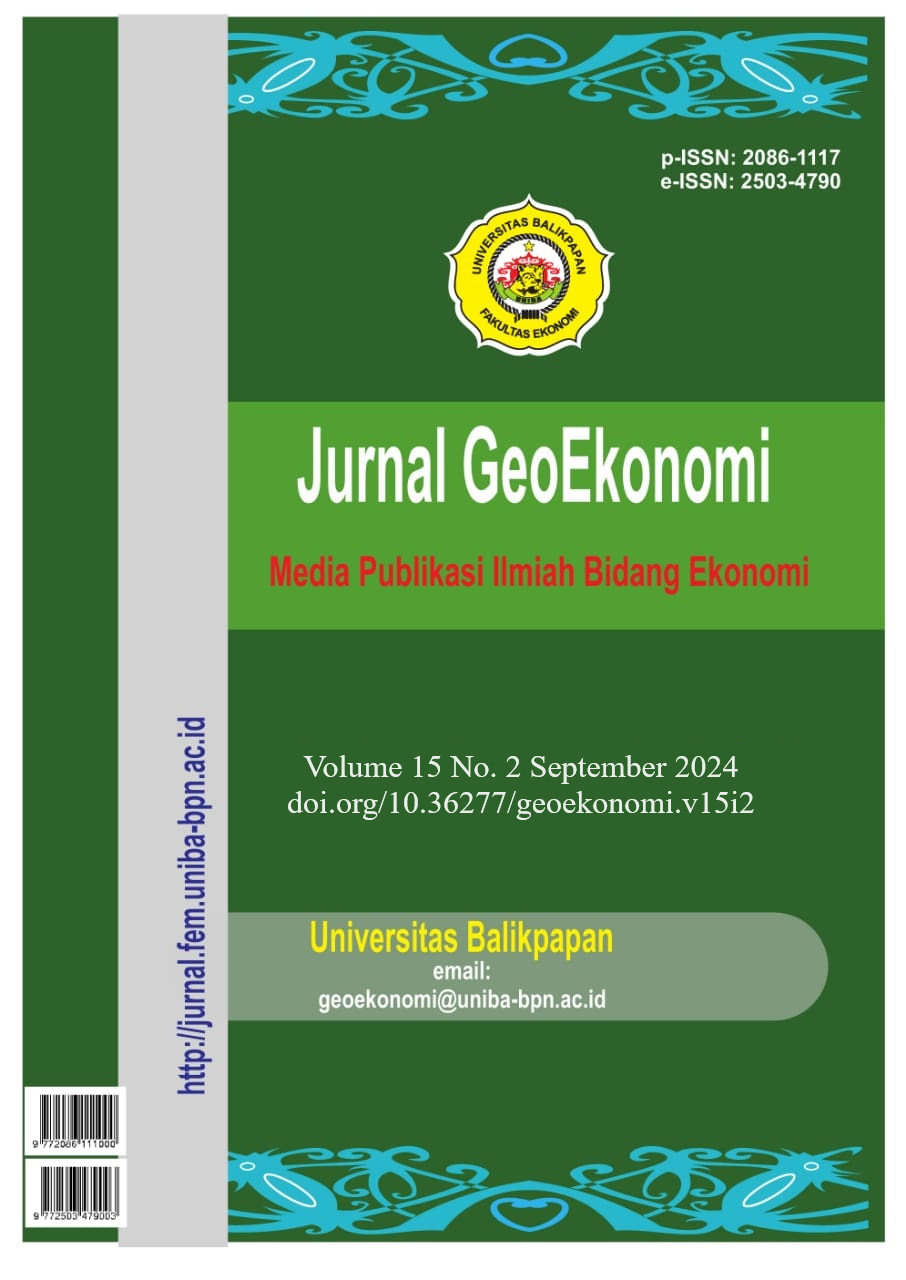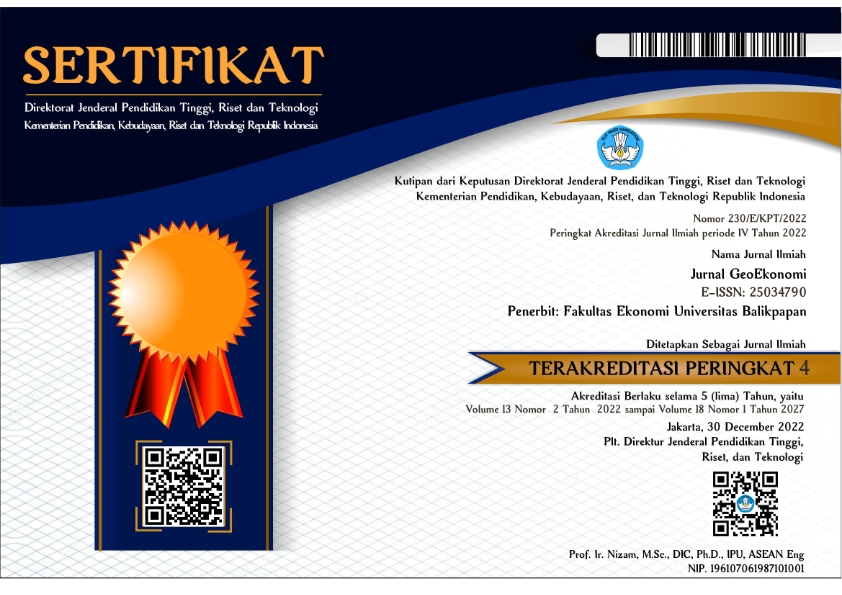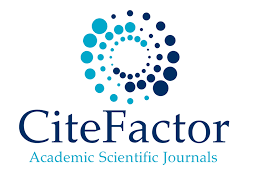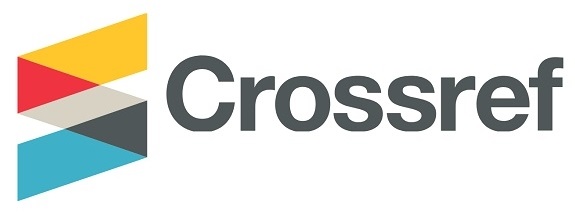MODAL SOSIAL DAN PELESTARIAN LINGKUNGAN MASYARAKAT BANTARAN SUNGAI JANGKOK KELURAHAN DASAN AGUNG KOTA MATARAM
DOI:
https://doi.org/10.36277/geoekonomi.v15i2.558Keywords:
Modal Sosial, Pelestarian Lingkungan, Sungai, JaringanAbstract
Based on the 2022 Indonesian Environmental Status document (SLHI 2022), 59.05% of rivers in Indonesia have the status of heavily polluted, 26.61% are moderately polluted and only 8.87% are lightly polluted which meet good quality status. Based on the results of observations by researchers in 2024 carried out in the field, quite a few riverbank residents in Dasan Agung sub-district have the habit of throwing rubbish on riverbanks, so this has a negative impact on the sustainability of the Jangkok River Basin. This is certainly an illustration of the weakness of the social capital system. local community. The aim of this research is to determine social capital strategies for environmental preservation and determine the best social capital for environmental preservation along the Jangkok River. This type of research is qualitative. and Quantitative. This research method uses questionnaires or questionnaires as well as interview observations to collect data, then the data is analyzed using linear regression data processing techniques using the SPSS program. The results of the research show that the effect of social capital on environmental conservation is 93%. This shows that social capital has a significant effect on environmental preservation in the communities along the Jangkuk River, Dasan Agung sub-district, Mataram city. The highest aspect of social capital is the network aspect at 55.73%, the trust aspect at 28.09 or 30.21%, while norms contribute 9.14 or 9.84%. The conclusion of this research is that social capital has a significant effect on environmental preservation on the banks of the Jangkok River, Dasan Agung Village, Mataram City, with the network aspect being the best option for preserving the environment on the banks of the Jangkok River, Dasan Agung Village.
Downloads
References
Aeni, K., Zamroni, Z., & Zuchdi, D. (2016). Pendayagunaan Modal Sosial Dalam Pendidikan Karakter. Jurnal Pembangunan Pendidikan: Fondasi Dan Aplikasi, 4(1), 30–42.
Claridge, T. (2018). Introduction to Social Capital Theory. In Social Capital Research. (Issue August, pp. 1–51). https://www.socialcapitalresearch.com/wp-content/uploads/edd/2018/08/Introduction-to-Social-Capital-Theory.pdf
Coleman, J. S. (1988). Social Capital in the Creation of Human Capital. American Journal of Sociology, 94(1), S95–S120. http://www.jstor.org/stable/2780243
Fraser, T., Aldrich, D., & Small, A. (2021). Connecting Social Capital and Vulnerability: Citation Network Analysis of Disaster Studies. Natural Hazards Review, 22. https://doi.org/10.1061/(ASCE)NH.1527-6996.0000469
Handoko, S. T. (2020). Kearifan Lokal Sebagai Modal Sosial Dalam Mengembangkan Perdamaian Di Papua. MASA : Journal of History, 1(2), 94–113. https://doi.org/10.31571/masa.v1i2.1633
Haridison, A. (2013). Modal Sosial Dalam Pembangunan. Jurnal Ilmu Sosioal, Politik, Dan Pemerintahan, 2(2), 35–43.
Hassanzadeh, J., Asadi-Lari, M., Baghbanian, A., Ghaem, H., Kassani, A., & Rezaianzadeh, A. (2016). Association between social capital, health-related quality of life, and mental health: A structural-equation modeling approach. Croatian Medical Journal, 57(1), 58–65. https://doi.org/10.3325/cmj.2016.57.58
Kementrian Lingkungan Hidup dan Kehutanan. (2022). Status Lingkungan Hidup Indonesia. In Laporan Status Lingkungan Hidup Indonesia 2022 olh Kementrian Lingkungan Hidup dan Kehutanan Republik Indonesia.
Purwoningsih, & Yuliastuti, N. (2014). Peran Modal Sosial Terhadap Kualitas Lingkungan Perumnas Banyumanik. Teknik PWK, 3(4), 553–563. https://ejournal3.undip.ac.id/index.php/pwk/article/view/6678
Ramli, M. (2021). Modal Sosial Masyarakat Dalam Menjaga Kelestarian Sungai (Studi Kasus Masyarakat Pinggiran Sungai Desa Kessing Kab.Soppeng). ALLIRI: Journal of Anthropology, 3(2), 1–7.
Simbolon, A. K. (2018). Analisis Modal Sosial untuk Kesejahteraan Masyarakat Lokal (Studi pada Wisata Petik Jeruk di Dusun Borogragal, Desa Donowarih, Kecamatan Karangploso, Kabupaten Malang). Cakrawala, 12(1), 85–96. https://doi.org/10.32781/cakrawala.v12i1.266
Solikatun, S., & Juniarsih, N. (2018). Modal Sosial Sebagai Srategi Bertahan Hidup Masyarakat Desa Maria, Kecamatan Wawo, Kabupaten Bima, Provinsi Nusa Tenggara Barat. Jurnal Analisa Sosiologi, 7(2), 262–273.
Swara, N. N. A. A. V., Wulandari, N. L. A. A., & Kawiana, I. G. P. (2022). Nilai Kearifan Lokal Nyepi Segara Sebagai Modal Sosial Pembangunan Berkelanjutan Daerah Pesisir Nusa Penida. Jayapangus Press (Jurnal Penelitian Agama Hindu), 6(4), 213–225.
Syafar, M. (2017). Modal Sosial Komunitas Dalam Pembangunan Sosial. UIN Sultan Maulana Hasanuddin Banten, 9, 1–22.
Upadani, I. G. A. W. (2017). Model Pemanfaatan Modal Sosial Dalam Pemberdayaan Masyarakat Pedesaan Mengelola Daerah Aliran Sungai (Das) Di Bali. Jurnal Lingkungan & Pembangunan, 1(1), 11–22.
Utami, V. Y. (2020). Dinamika Modal Sosial Dalam Pemberdayaan Masyarakat Pada Desa Wisata Halal Setanggor: Kepercayaan, Jaringan Sosial Dan Norma. Reformasi, 10(1), 34–44. https://doi.org/10.33366/rfr.v10i1.1604
Downloads
Published
How to Cite
Issue
Section
License
Copyright (c) 2024 Agum Muladi, Ibrahim Ali, Nurhayati

This work is licensed under a Creative Commons Attribution 4.0 International License.
You are free to:
Share - copy and redistribute the materials in any medium or format for any purpose, even for commercial purposes.
Adapt - compose, change and develop the material for any purpose, even for commercial purposes.
The licensor cannot revoke these freedoms as long as you follow the license terms.
With the following conditions:
Attribution - you must give appropriate credit, provide a link to the license, and indicate if changes have been made. You may do so in a reasonable manner, but not in any way that suggests that the licensor endorses you or your use.
No additional restrictions - You may not implement legal provisions or technological measures that legally restrict others from doing anything permitted by the license.
Notice:
You do not have to comply with the license for elements of the material that are in the public domain or where your use is permitted by an applicable exclusion or restriction.
No warranties are given. This license may not grant all the permissions necessary for your intended use. For example, other rights such as publicity, privacy, or moral rights may limit how you use the material.







_geoekonomi.png)
_geoekonomi.png)
















